There are many ways to grow plants. Everybody has heard about hydroponics, growing soilless. Hydroponics itself is more of a catchall term that defines the soil being absent, but not the actual technique being used for growing.
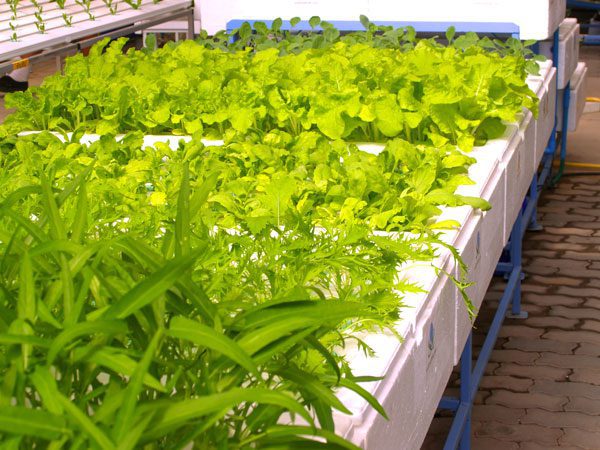
Let’s explore the different types of hydroponics that are most successful and commonly used. We will look at why each of these systems has a place in the world of growing. You’ll see the pros and cons for each system and why to use them in certain specific situations. None of the systems is the best per se, but in each different situation there will be a system that is best suited for the application. I’m going to make it easy to pick which type of hydro to use in any given situation suiting your needs.
1. NFT Hydroponics System
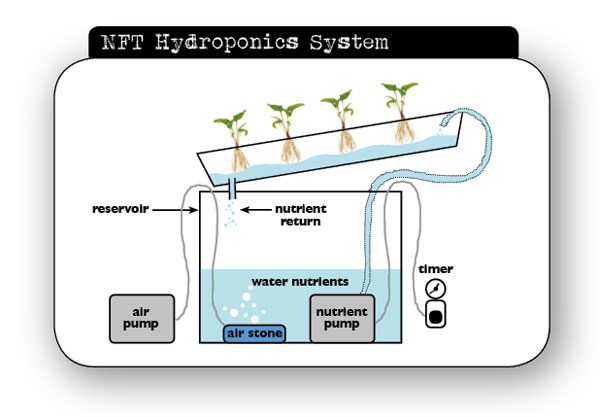
NFT or “Nutrient Film Technique” uses a flat growing surface positioned at a slight decline. A thin ‘film’ of nutrient solution is continuously running along the surface of the growing table. Usually, plants are held in place by neoprene discs, or rooted in rock-wool cubes to create the anchoring needed so plants won’t wash away or fall over. The film of water is usually a fraction of an inch deep, with most of the roots actually being out of the water. The roots will get plenty of aeration, which in turn should lower the risk of root problems. It is, however, vital to protect the roots from light and to keep them a bit moist. A cover for the growing table is important to regulate the moisture content of the air around the roots.
NFT systems are usually recirculating. The nutrient solution constantly flows past the roots, and even though it’s just a thin film, there will be plenty of water moving past the plant roots. Disposing of the nutrient solution after one pass would increase water consumption in a massive way, and will be destructive to garden efficiency, which you would normally expect hydro to offer. Depending on the plants and their nutrient consumption, the pH and EC levels of the nutrient solution will gradually change as it passes through the plant roots. Because of this gradual change, it is advisable to increase the number of growing tables instead of their length.
Since NFT is utilizing a thin film of water that is constantly flowing it’s absolutely vital that the water keeps moving. If the water stops moving for whatever reason, the plants quickly start to show severe drought problems. It is therefore advisable to use two pumps for the same application. In case one of the pumps breaks the other will still keep the roots moist. Root zone temperature control can be ideal in an NFT system, but it can also become the Achilles heel. If the root zone is properly insulated from outside temperature influences it will only take a small amount of energy to increase or decrease the nutrient temperature, an essential part of hydroponics. If the root zone is not shielded from these outside influences the temperature will most likely get too high during the day. One of the biggest advantages due to this is the small amount of nutrient solution in use, although some kind of buffering is always a good thing.
2. DWC Hydroponics
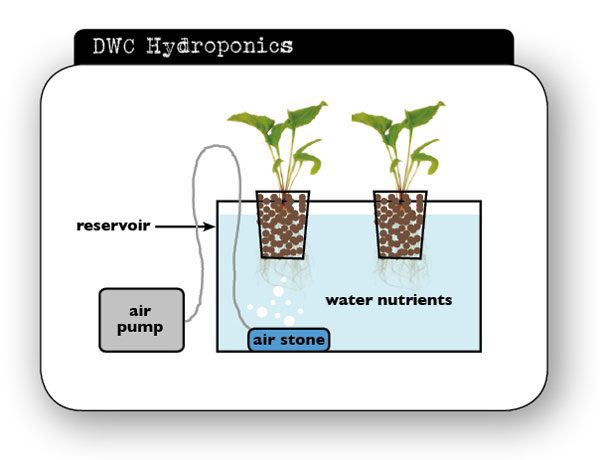
The key in aquaponics is to get everything the plant needs to the plant as efficiently as possible. Deep Water Culture does exactly that, it saturates the roots in a supply of nutrient solution while also adding oxygen to prevent suffocation of the roots. Deepwater culture systems vary in size, each plant can have an individual unit, or you can grow a number of plants in the same container. The size of the container determines how much buffer capacity the system has, a bigger container will lead to more stability in temperature, pH, and EC. The drawbacks of having large containers is that it requires a lot of water to fill them, and in some cases, a lot of energy to heat it to a suitable temperature.
Plants are in net-pots filled with a medium such as clay pebbles, but can also be suspended above the water using neoprene discs. A common method used in lettuce farms is to use styrofoam boards to suspend plants. A big advantage in doing this is the ability to grow plants close together when they are small and placing them in another styrofoam board when they have grown. In this way you know you have full occupancy, boosting overall production. The most important thing to remember is that the water in a DWC must have constant oxygenation. This can either be done by using a venturi type air inlet on the circulation pump, or by using air pumps. The air can also be added into the root zone directly which is even better than just oxygenating the nutrient solution.
DWC is especially suited for places with high daytime temperatures and cooler nights. The buffering capacity that comes from the high volume of water slows down the cooling of the water, lowering the energy bill. The amount of overall engineering in the system is not too high, and pump failures are not as catastrophic as other hydro systems. The cost or availability of (chlorine-free) water can form a prohibitive factor in some places though.
3. Aeroponics & Aero Hydroponics
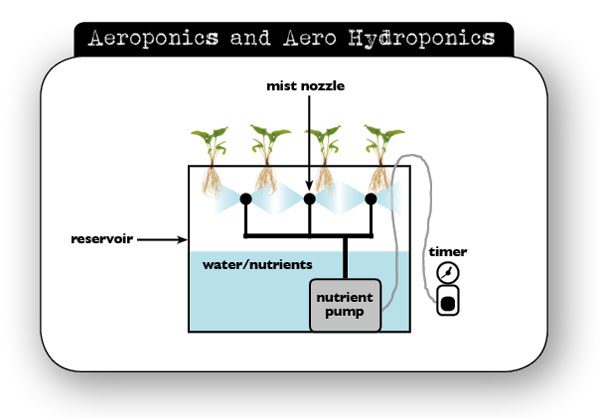
The most high-tech solution to growing plants in a hydroponic setup is aeroponics. These kinds of systems are probably not suited for beginners due to their complexity. Aeroponics systems are a sort of opposite to Deep Water Culture. Opposed to a container filled with oxygenated water these systems use a container with air saturated with a mist of nutrient solution.
Plants are usually suspended with neoprene disks. Net-pots don’t really work because they allow for the nutrient mist to escape which leaves salt spots everywhere it goes. The mist is usually made by pumping water with pressure through a nozzle which creates a fine mist. Obviously, it’s important that the plumbing be correct.
Cleaning the system often is necessary to make sure the nozzles don’t clog up. Overall these systems probably do more to increase the risk of catastrophic failure.
Like NFT, aeroponics systems don’t do well should a power or pump failure occur. Roots will dry out and leaves will soon start to lose their means to evaporate and stay cool. In theory, this is the best method of controlling the root climate and nutrient supply. How this works out, in reality, depends on the quality of the system’s design.
4. Conventional Hydroponics Grow System
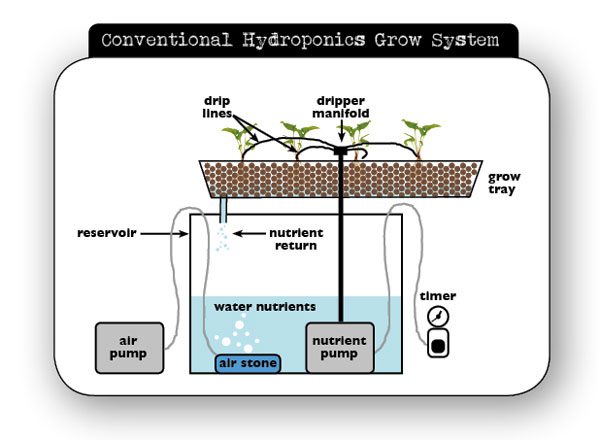
The most conventional form of hydro growing is simply to replace the soil with another – inert – medium. Even though this resembles soil, the characteristics of growing are totally different. The grower has full control over the nutrient supply but the water absorption and drainage characteristics of the medium can usually be maintained for longer periods of time than soil giving these simple methods advantages over soil-growth.
The two best-known mediums in conventional hydroponics are clay pebbles and rock-wool. Rock-wool has better absorption properties, and clay pebbles drain very well. Both are good mediums for root growth and are reusable. Conventional hydro systems are either recirculating or drain-to-waste. They give you timed or constant flow options, depending on the medium used. A medium such as clay pebbles that drains well will do better in a constant flow type situation. Rock-wool, on the other hand, will perform better with a timed water supply since the rock-wool itself will absorb water to keep the roots moist. Conventional hydro is probably the best starting point for people looking into hydroponics systems. It’s the simplest to set up and the least likely to fail horribly.
5. Ebb and Flow Hydroponics Systems
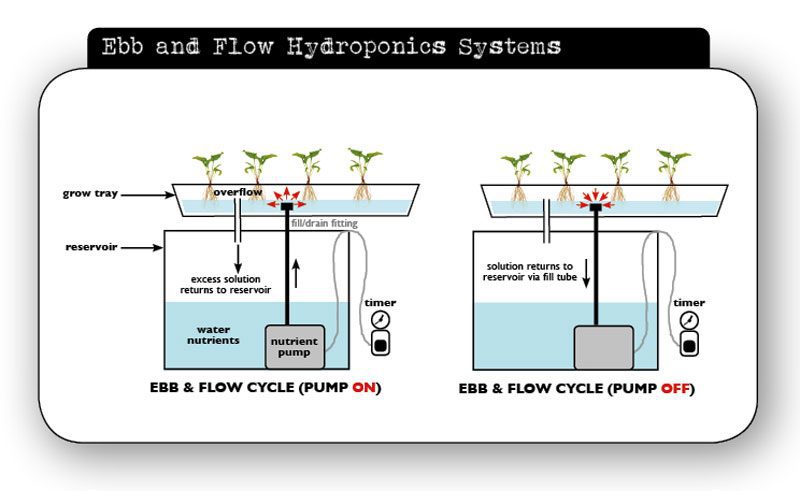
A slight adaptation to conventional hydro is Ebb and Flow, plants in these systems get watered from below for a set amount of time. This is one of the best systems to use when recycling nutrients. Nutrient solution pumps out below the plants. The grower then allows the plant and medium some time to absorb the moisture, then the excess drains off again. Usually, plants receive 5 to 15 minutes of high water levels, and then a longer period without a nutrient solution on the roots.
Technically, Ebb and Flow is a little more demanding than a conventional hydro system, using a little more plumbing to control the water height. Planting young plants requires some planning, plants need to have roots long enough to come into contact with the water. Especially if they are grown on clay pebbles. However, it is easy to move around plants in their individual pots. Unlike other systems, there are drip lines connected to the pots so moving them is easy.
These systems are perfect for experienced hydro growers that want to have good control of their nutrient solution as it’s easy to measure what the difference in pH and EC is in between every flooding. The difference between Ebb and Flow and conventional hydro comes down to preference. Neither is a better system and both work about the same. It’s really up to the individual user and their location which determines which system should be chosen.
Other Things to Note
All these systems still do the same essential thing, deliver a nutrient solution to the plant roots, and providing this in an oxygenated environment. Choosing which system to use has a lot to do with personal preference. The taking into account of your location is a good thing, in a cold environment a lot of water will be expensive to heat. On the other hand, a smaller buffer of nutrient solution will need more management to keep the values within the right range.
A good grower can probably have success with any of these systems in any kind of situation. An experienced grower, however, is more likely to pick a more simple system that has less chance of catastrophic failure. That is also the key to hydro, a small error in judgment or a power failure can result in mass plant death. A well-designed system has fail-safes to make sure this does not happen!
Is there technique for hydroponic using hardware and software
Hola soy luciano anibal savelli de mendoza argentina. Saben de la técnica de jardines verticales. . Un tema a a practicar. Ya que es mas fácil que el cultivo horizontal. Dándole vegetación. A tantos muros libres.
Hola Luciano,
Jardines verticales son grandes para crecer más en un espacio reducido. Si son instalaciones hidropónicos van a utilizar una de estas técnicas.